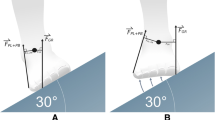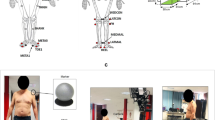Abstract
The objective of this study was to investigate the electrical activity of lower limb muscles during gait in an able-bodied control group and in deaf individuals. Thirty male children were equally divided into a control group and a group of deaf children. A portable EMG system was used to record the activity of the bilateral tibialis anterior, gastrocnemius medialis and vastus lateralis muscles during barefoot walking with and without dual task. For EMG analysis, the average root mean square (RMS) values of the five trials were calculated and then normalized based on the peak RMS obtained by the maximum isometric voluntary contraction. MANOVA test was used for between group comparisons. The significance level was set at p < 0.05 for all analyses. The findings indicated that gait speed in children with hearing loss was smaller than that in control group. Dual task resulted in a decreased walking speed of children with hearing loss. The activities of tibialis anterior muscle in terminal stance phase (p = 0.040), medial gastrocnemius muscle in loading response and initial swing phases (p < 0.05), and vastus lateralis muscle in the terminal stance and pre swing phases (p < 0.05) were greater in deaf group. In deaf children the gait speed was reduced and the muscle activity was increased with respect to those in control group. This altered gait speed and muscle activity is suggestive of a lower mechanical efficiency of gait in deaf children.






Similar content being viewed by others
References
Pavao SL, dos Santos AN, de Oliveira AB, Rocha NACF (2014) Functionality level and its relation to postural control during sitting-to-stand movement in children with cerebral palsy. Res Dev Disabil 35(2):506–511
Pollock AS, Durward BR, Rowe PJ, Paul JP (2000) What is balance? Clin Rehabil 14(4):402–406
Dutt-Mazumder A, Challis J, Newell K (2016) Maintenance of postural stability as a function of tilted base of support. Hum Mov Sci 48:91–101
Horak FB, Shumway-Cook A, Crowe TK, Black FO (1988) Vestibular function and motor proficiency of children with impaired hearing, or with learning disability and motor impairments. Dev Med Child Neurol 30(1):64–79
Crowe TK, Horak FB (1988) Motor proficiency associated with vestibular deficits in children with hearing impairments. Phys Ther 68(10):1493–1499
Rine R, Spielholz N, Buchman C (2001) Postural control in children with sensorineural hearing loss and vestibular hypofunction: deficits in sensory system effectiveness and vestibulospinal function. In: Duysens J, Smit-Engelsman BCM, Kingma H, (eds.) Control of posture and gait. Springer, Amsterdam, pp 40–45
Rine RM, Braswell J, Fisher D, Joyce K, Kalar K, Shaffer M (2004) Improvement of motor development and postural control following intervention in children with sensorineural hearing loss and vestibular impairment. Int J Pediatr Otorhinolaryngol 68(9):1141–1148
Vitkovic J, Le C, Lee S-L, Clark RA (2016) The contribution of hearing and hearing loss to balance control. Audiol Neurotol 21(4):195–202
McGibbon CA, Krebs DE, Parker SW, Scarborough DM, Wayne PM, Wolf SL (2005) Tai Chi and vestibular rehabilitation improve vestibulopathic gait via different neuromuscular mechanisms: preliminary report. BMC Neurol 5(1):3
Mkacher W, Tabka Z, Trabelsi Y (2016) Relationship between postural balance, lung function, nutritional status and functional capacity in patients with chronic obstructive pulmonary disease. Sci Sports 31(2):88–94
Tucker CA, Ramirez J, Krebs DE, Riley PO (1998) Center of gravity dynamic stability in normal and vestibulopathic gait. Gait & Posture 8 (2):117–123
Krebs DE, Goldvasser D, Lockert JD, Portney LG, Gill-Body KM (2002) Is base of support greater in unsteady gait? Phys Ther 82(2):138–147
Marchetti GF, Whitney SL, Blatt PJ, Morris LO, Vance JM (2008) Temporal and spatial characteristics of gait during performance of the dynamic gait index in people with and people without balance or vestibular disorders. Phys Ther 88(5):640–651
Ishikawa K, Wang Y, Wong WH, Shibata Y, Itasaka Y (2004) Gait instability in patients with acoustic neuroma. Acta Otolaryngol 124(4):486–489
Perring S, Summers T (2007) Laboratory-free measurement of gait rhythmicity in the assessment of the degree of impairment and the effectiveness of rehabilitation in patients with vertigo resulting from vestibular hypofunction. Physiol Meas 28(6):697
Cavanaugh JT, Goldvasser D, McGibbon CA, Krebs DE (2005) Comparison of head-and body-velocity trajectories during locomotion among healthy and vestibulopathic subjects. J Rehabil Res Dev 42(2):191
Tun PA, McCoy S, Wingfield A (2009) Aging, hearing acuity, and the attentional costs of effortful listening. Psychol Aging 24(3):761
Lin FR, Ferrucci L, Metter EJ, An Y, Zonderman AB, Resnick SM (2011) Hearing loss and cognition in the Baltimore longitudinal study of aging. Neuropsychology 25(6):763
Strawbridge WJ, Wallhagen MI, Shema SJ, Kaplan GA (2000) Negative consequences of hearing impairment in old age a longitudinal analysis. Gerontologist 40(3):320–326
Li L, Simonsick EM, Ferrucci L, Lin FR (2013) Hearing loss and gait speed among older adults in the United States. Gait & Posture 38(1):25–29
Horstmann T, Listringhaus R, Haase G-B, Grau S, Mündermann A (2013) Changes in gait patterns and muscle activity following total hip arthroplasty: a six-month follow-up. Clin Biomech 28(7):762–769
Kleissen R, Litjens M, Baten C, Harlaar J, Hof A, Zilvold G (1997) Consistency of surface EMG patterns obtained during gait from three laboratories using standardised measurement technique. Gait & Posture 6(3):200–209
Meyns P, Van Gestel L, Bruijn SM, Desloovere K, Swinnen SP, Duysens J (2012) Is interlimb coordination during walking preserved in children with cerebral palsy? Res Dev Disabil 33(5):1418–1428. doi:10.1016/j.ridd.2012.03.020
Bull R, Scerif G (2001) Executive functioning as a predictor of children’s mathematics ability: Inhibition, switching, and working memory. Dev Neuropsychol 19(3):273–293
Hermens HJ, Freriks B, Disselhorst-Klug C, Rau G (2000) Development of recommendations for SEMG sensors and sensor placement procedures. J Electromyogr Kinesiol 10(5):361–374
Whittle MW (2014) Gait analysis: an introduction, Butterworth-Heinemann, Edinburgh
Craig CE, Goble DJ, Doumas M (2016) Proprioceptive acuity predicts muscle co-contraction of the tibialis anterior and gastrocnemius medialis in older adults’ dynamic postural control. Neuroscience 322:251–261
Escamilla RF, Fleisig GS, Zheng N, Lander JE, Barrentine SW, Andrews JR, Bergemann BW, Moorman CT (2001) Effects of technique variations on knee biomechanics during the squat and leg press. Med Sci Sports Exerc 33(9):1552–1566
Escamilla RF, Lewis C, Bell D, Bramblet G, Daffron J, Lambert S, Pecson A, Imamura R, Paulos L, Andrews JR (2010) Core muscle activation during Swiss ball and traditional abdominal exercises. J Orthop Sports Phys Ther 40(5):265–276
Figueras B, Edwards L, Langdon D (2008) Executive function and language in deaf children. J Deaf Stud Deaf Educ 13(3):362–377
Rehkemper GM (1996) Executive functioning and psychosocial adjustment in deaf subjects with non-hereditary and hereditary etiologies. Dissertation, Gallaudet University
Roth RM, Gioia GA (2005) Behavior rating inventory of executive function-adult version. Psychological Assessment Resources, Lutz, FL
Klenberg L, Korkman M, Lahti-Nuuttila P (2001) Differential development of attention and executive functions in 3-to 12-year-old Finnish children. Dev Neuropsychol 20(1):407–428
Marschark M, Hauser PC (2008) Deaf cognition: foundations and outcomes. Oxford University Press, New York
Majlesi M, Farahpour N, Azadian E, Amini M (2014) The effect of interventional proprioceptive training on static balance and gait in deaf children. Res Dev Disabil 35(12):3562–3567
Perry J, Davids JR (1992) Gait analysis: normal and pathological function. J Pediatr Orthop 12(6):815
Di Nardo F, Mengarelli A, Burattini L, Maranesi E, Agostini V, Nascimbeni A, Knaflitz M, Fioretti S (2016) Normative EMG patterns of ankle muscle co-contractions in school-age children during gait. Gait & Posture 46:161–166
Di Nardo F, Ghetti G, Fioretti S (2013) Assessment of the activation modalities of gastrocnemius lateralis and tibialis anterior during gait: a statistical analysis. J Electromyogr Kinesiol 23(6):1428–1433
Winter DA (2009) Biomechanics and motor control of human movement. Wiley, Hoboken, NJ
Sutherland DH, Olshen R, Cooper L, Woo SL (1980) The development of mature gait. J Bone Joint Surg Am 62(3):336–353
Lee SS, Piazza SJ (2008) Inversion–eversion moment arms of gastrocnemius and tibialis anterior measured in vivo. J Biomech 41(16):3366–3370
Di Nardo F, Mengarelli A, Maranesi E, Burattini L, Fioretti S (2015) Assessment of the ankle muscle co-contraction during normal gait: a surface electromyography study. J Electromyogr Kinesiol 25(2):347–354
Acknowledgements
The authors gratefully acknowledge the financial support for this work provided by Islamic Azad University, Hamedan Branch, Hamedan, Iran. We are grateful to Dr. Ali Gholami Mehrdad for reading and correcting the English text. We also wish to thank the honorable managing director of the Alaghbandian School in Hamedan, Mrs. Banisafar, and all of the subjects who participated in the study.
Funding
This study was funded by Islamic Azad University, Hamedan Branch, Hamedan, Iran.
Author information
Authors and Affiliations
Corresponding author
Ethics declarations
Conflict of interest
The authors declare that they have no conflict of interest.
Ethical approval
All procedures performed in studies involving human participants were in accordance with the ethical standards of the institutional and/or national research committee and with the 1964 Helsinki declaration and its later amendments or comparable ethical standards.
Informed consent
Informed consent was obtained from all individual participants included in the study.
Rights and permissions
About this article
Cite this article
Majlesi, M., Azadian, E., Farahpour, N. et al. Lower limb muscle activity during gait in individuals with hearing loss. Australas Phys Eng Sci Med 40, 659–665 (2017). https://doi.org/10.1007/s13246-017-0574-y
Received:
Accepted:
Published:
Issue Date:
DOI: https://doi.org/10.1007/s13246-017-0574-y




